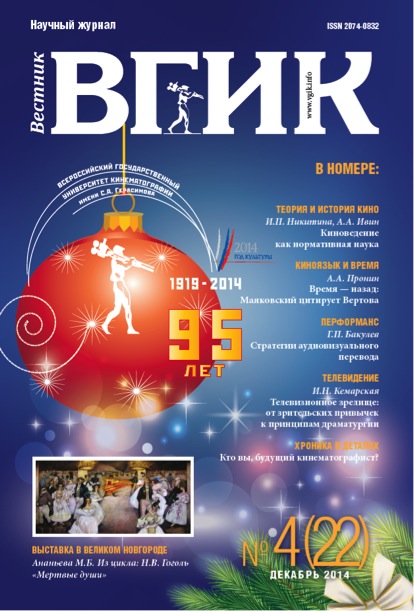TV- Show: From the Audience Habits To Principles of Dramaturgy
- 作者: Kemarskaya I.N.1
-
隶属关系:
- Federal State Educational Establishment for Continuing Professional Education “Media Industry Academy”
- 期: 卷 6, 编号 4 (2014)
- 页面: 126-136
- 栏目: TELEVISION | DIGITAL ENVIRONMENT
- URL: https://journals.eco-vector.com/2074-0832/article/view/14816
- DOI: https://doi.org/10.17816/VGIK64126-136
- ID: 14816
如何引用文章
全文:
详细
The article is devoted to the scriptwriting of TV shows and the role of the social practices of TV-viewing in the creation of script plot of periodical programs. Script construction of contemporary TV shows differs greatly from the classical film screenwriting due to its primarily focusing on predicted audience reactions in every single moment of broadcasting. The show creators are directed by the intention of giving the viewer the opportunities to feel the emotions he/she anticipates watching every new issue of the program. In order to attract the audience to the screen, hold it, to ensure its return to the favorite show the TV creators are obliged to imagine the established rituals and social practices of screen viewing. The paper covers the historical aspects of the social TV viewing practices, their formation and dynamics, from the Soviet "collective viewing" in a communal apartments with a sole TV-set up to a contemporary tendency of individual “binge-watching” of full ser seasons through internet services. The author specially emphasizes gender, generational, socio-demographic differences in TV watching and their influence on different creative techniques and discoveries. As to the gender habits of audiovisual information perception, the author pays attention to the so called "female" way of TV watching, characteristic of empathy, emotional involvement in the perception of the show, against the "male" choice of action, spectacle dynamics and often simultaneous viewing of different channels. Changes in common practices of TV watching cause the script decisions, adapted to the habitual behavior of different audience groups (shortening of audiovisual elements within programs, clip cutting, priority of emotion over logic-screen narration, etc.). Resume: rapid changes of screen watching social practices challenge the well-known creative technologies, turning the familiar TV shows into the part of the hypertext with different logic of reading and understanding.
关键词
作者简介
Irina Kemarskaya
Federal State Educational Establishment for Continuing Professional Education “Media Industry Academy”
编辑信件的主要联系方式.
Email: kemarskaya2012@gmail.com
PhD in Philology, leading researcher
参考
- Борецкий Р.А. В Бермудском треугольнике ТВ / под общей редакцией Я.Н. Засурского. - М.: ИКАР; Факультет журналистики МГУ, 1998 - 204 с.
- Кемарская И.Н. Телевизионный редактор: учеб. пособие для студентов вузов. - М.: Аспект Пресс, 2009 - 191 с.
- Российское телевидение: между спросом и предложением: в 2 томах. Том 1 / [под ред. - А.Г. Качкаевой, И.В. Кирия. - М.: Элиткомстар, 2007 - 328 с.
- Телевизионный сценарий / Сборник сценариев телевизионных передач и фильмов; под ред. Э.Г. Багирова. - М.: Изд-во Моск. ун-та, 1975. - 176 с.
- Телерадиоэфир: история и современность / под ред. А.Г. Качкаевой. - М.: Элиткомстар, 2008 - 400 с.
补充文件







